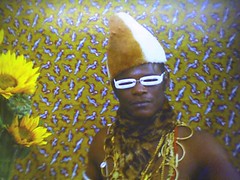
At Gloucester Road there is a series of self portraits by a photographer who has desguised himself in each picture. It is part of London Underground’s Platform Art series.
I boought the tenth anniversary reissue of the original Renaissance mix album by Sasha and John Digweed. Renaissance is hailed by many clubbers as being revolutionary. I thought I would comment on some of the innovations:
– Renaissance was the birth of progressive house: no it wasn’t you can hear a natural progression between early Renaissance and Sasha’s sets before the club was formed. Renaissance was built on the back of the reputation that Sasha had earned at Shelly’s in Hanley, Stoke-on-Trent. Progressive house had been put out for a fair while by artists, most notably the Italian acts Sueno Latino and Last Rhythm. Fabi Paras had championed the sound in London.
– Renaissance changed the visual language of clubbing: kind of. Renaissance got its name from borrowing fromrenaissance paintings, which were deconstructed and repurposed, however from the early days of house, many club flyers and imagery was borrowed from the cheesier ‘catholic’ religious art.
– Renaissance was a life changing experience: It depends where your head was at. Renaissance was a good club, they managed to get all the ingredients right: the security, the staff, the clubbers, the venue, the ambience, the music and the DJs. People had a great time, but then in club culture during the early 1990s there was a lot of great times to be had every weekend all over the country.
– Renaissance revived clubbing: Don’t believe the hype. Renaissance caught the top of the clubbing wave. It was one of a number of clubs that issued in a glitzy waye: straight lads wearning Versace shirts and leather trousers. Another trend to benefit was the mixed gay straight clubs like Vague in Leeds. The reasons why this came about was as much to do with getting a licence as baggy clothes for dancing meant wholesale drug use and possible dealer rumbles. Mincing around the club in clothes you would be afraid to sweat in was supposed to prevent it, it didn’t it just heralded the arrival of wholesale cocaine use. It replaced the egalitarian nature of house and rave with snobbishness.
My recollections of Renaissance
It was towards the end of 1992, a friend of mine had got a gig on a Friday night at the Venue 44 in Mansfield playing what would now be termed drum and bass. I knew him as we used to play house sets together. He had met a couple in some ski resort where he had gone to play for a couple of months. The couple were involved in putting club flyers in shops and bars throughout the Midlands and the North of England. When he came back, he got in touch with the couple and they got him the gig.
I turned up to a half empty night decked out in decorations. After I made some enquiries, I got into Renaissance for free a few weeks later. I remember having a nightmare parking the Austin Metro I had at the time and stiff legs from the two-hour drive that did not welcome the stairs I had to climb to the front door. The building looked anonymous and whitewashed on the outside.
The main dance floor had the DJ booth well above it and there was a chill out area between the front door and the barn like dance floor with bench seating and some sort of trellices. Most of the lads going there looked like rugby league players and the girls like night wear models. The club had a buzz, but it was not the raw electric feel of Shellys, The Hacienda or the Quadrant Park. More related content here.
 From romantic Korean drams to hard boiled films like Old Boy and Silmido are making waves amongst arthouse cinema fans and movie industry talent-spotters throughout the western world. It now seems that its not only Hollywood that is turning its eyes eastwards to follow the latest cultural carrying-ons in Korea, but Chinese eyes are too.
From romantic Korean drams to hard boiled films like Old Boy and Silmido are making waves amongst arthouse cinema fans and movie industry talent-spotters throughout the western world. It now seems that its not only Hollywood that is turning its eyes eastwards to follow the latest cultural carrying-ons in Korea, but Chinese eyes are too. 
